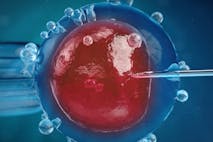
Welsh women denied needed pregnancy medication are getting abortions
Cassy Cooke
·
Responding to pro-abortion columnist Kellie Quinn
The following is a response to excerpts from a column published by The Daily Collegian by Kellie Quinn.
“On Nov. 8, voters in Mississippi shot down an amendment that would grant personhood rights to a fertilized human egg. This amendment, had it passed, would have labeled abortions as murder and would have subsequently banned almost all abortions, even if the pregnancy was the result of rape or incest. Additionally, this amendment would intrude even farther into womens’ reproductive health and outlaw certain methods of contraception.”
I can’t count how many times I have encountered the mythological “fertilized human egg” notion. Science has proven that at the moment of conception, a new human being has come into existence. No longer is there a sperm and an egg, but a complete, growing, developing human being. But still, misinformed abortion-rights advocates cling tight to the “fertilized egg” idea. I guess it helps them justify promoting hormonal birth control methods that can act as abortifacients, disallowing newly conceived human beings from implanting in their mothers’ wombs.
The Personhood amendment that failed in Mississippi would have defined human beings in the womb as persons, but a state law cannot trump federal—this law, if it had passed, would have sent a message to America that Mississippi is pro-life, but it would not have altered abortion or birth control laws in any way.
“Intrauterine devices (IUDs), and morning after pills like “Plan B” would be banned because they can prevent fertilized eggs from implanting in the uterine lining. According to Planned Parenthood, there is actually no data to support this claim as an IUD’s purpose is to prevent fertilization in the first place.”
Hormonal IUDs have the potential, just like any other hormonal birth control method, to cause an early abortion. I can’t feign surprise that Planned Parenthood’s website is lacking in regard to facts about birth control and abortion.
“The inspiration behind the amendment was undeniably religious and supports the belief that life begins at conception.”
I think it’s safe to say that for many pro-lifers, support for the amendment stems not just from a personal “belief,” but from a scientific fact that life begins at conception. One doesn’t need to be religious in any way to realize that killing another human being is wrong.
“…When unplanned pregnancies are portrayed in films and television, abortion is often quickly dismissed as out of the question…In “Juno,” title character Juno is talked out of getting an abortion when she learns the baby has fingernails. But are fingernails really the defining factor for determining what is human? Is that how we define life, whether or not fingernails are present? That is how it comes across in “Juno,” that the fetus is a person because it has fingernails. But realistically, is it our fingernails that define us as humans? What if you lose your hands in an accident? Are you then no longer a person since you are without fingernails?”
In the scene from Juno that Ms. Quinn is referring to, Juno’s friend explains to her that her baby has a beating heart and can feel pain, and that he or she has fingernails. By the time an unborn child has developed fingernails, he or she has had a beating heart for weeks. The idea her child had fingernails already may have been what changed Juno’s mind and made her realize her child is truly alive, but in no way does that mean that’s how we define life. I’ll reiterate, once again…we define life by what science has proved to us.
Article continues below
Dear Reader,
In 2026, Live Action is heading straight where the battle is fiercest: college campuses.
We have a bold initiative to establish 100 Live Action campus chapters within the next year, and your partnership will make it a success!
Your support today will help train and equip young leaders, bring Live Action’s educational content into academic environments, host on-campus events and debates, and empower students to challenge the pro-abortion status quo with truth and compassion.
Invest in pro-life grassroots outreach and cultural formation with your DOUBLED year-end gift!
“These messages make embryos and fetuses seem more human-like than they actually are. A fetus is not even considered as such until 10 weeks, before that it is still only an embryo. At 10 weeks it is only about as large as a strawberry, at 12 weeks it is around two and a half inches in length. Approximately 88 percent of abortions take place before 12 weeks, meaning before the fetus is even as large as your thumb.”
“Seem more human-like than they actually are?” Simply because a human being doesn’t “seem” human doesn’t mean they’re sub-human in any way. Who are we to inflict upon others this obtuse subjectivity of who merits the right to life?
“Granted it has fingernails, but is this how we define personhood? Or is it defined by the ability to feel pain because 12-week-old fetuses can feel pain? If this is the case then individuals with Hereditary Sensory and Autonomic Neuropathy, a disorder that inhibits the ability to feel pain, would not be people.”
I have to applaud the acknowledgment that 12-week-old unborn children can, in fact, feel pain, because few and far between are there abortion-rights advocates who admit such a thing.
However, this is not what defines personhood. To warrant the most fundamental of all rights—the right to life—it would make sense that being a human being would be sufficient (once more: science proves a human being comes into existence at conception). But here we are, still fighting this battle to end what could be the gravest injustice our world has ever known.
“What is it about these embryos and fetuses that are so human-like? Is it the potential for the life they have? If so, then should we then be basing more policies based on potential?”
No human being as a “potential life.” They do, however, have a life that is full of potential. We should be making laws and policies to protect these lives so they can live up to their potential, and repealing laws that revoke their right to life.
“Why are we seeking to remove rights from fully developed humans for the purpose of granting additional rights to humans that do not have much, if any, brain processing yet?”
We aren’t looking to “remove rights from fully developed humans.” We’re looking to grant basic human rights to every and all human beings, including preborn ones. However, if we were to grant fundamental rights to human beings in correlation to how developed they are, we’d be granting more protection of these rights to full-grown adults than we do to teenagers; more to teenagers than small children.
Oh, and brainwaves are present and detectable in unborn children by 7 weeks after conception, before even their little fingernails form.
Live Action News is pro-life news and commentary from a pro-life perspective.
Contact editor@liveaction.org for questions, corrections, or if you are seeking permission to reprint any Live Action News content.
Guest Articles: To submit a guest article to Live Action News, email editor@liveaction.org with an attached Word document of 800-1000 words. Please also attach any photos relevant to your submission if applicable. If your submission is accepted for publication, you will be notified within three weeks. Guest articles are not compensated (see our Open License Agreement). Thank you for your interest in Live Action News!

Cassy Cooke
·
Guest Column
Emily Berning
·
Opinion
Nancy Flanders
·
Opinion
Mark Wiltz
·
Opinion
Mark Wiltz
·
Pop Culture
Madison Evans
·
Guest Column
Guest Contributor
·
Guest Column
Guest Contributor
·
Guest Column
Guest Contributor
·
Guest Column
Guest Contributor
·
Guest Column
Guest Contributor
·